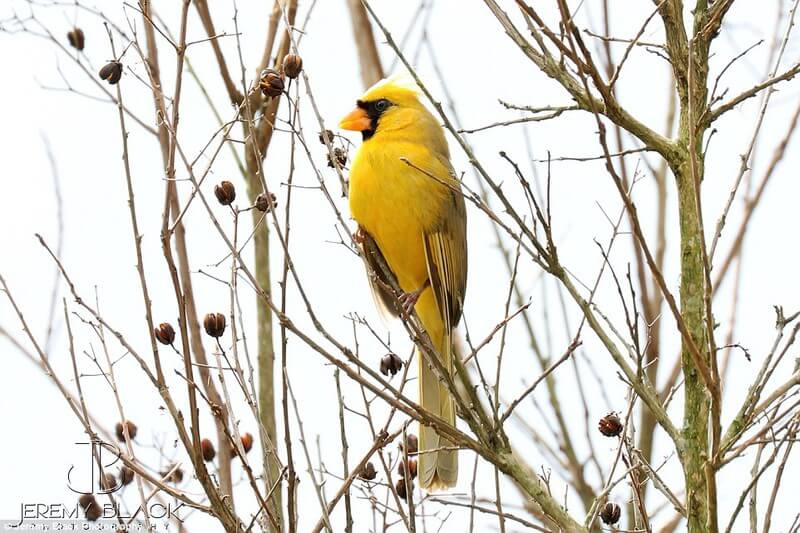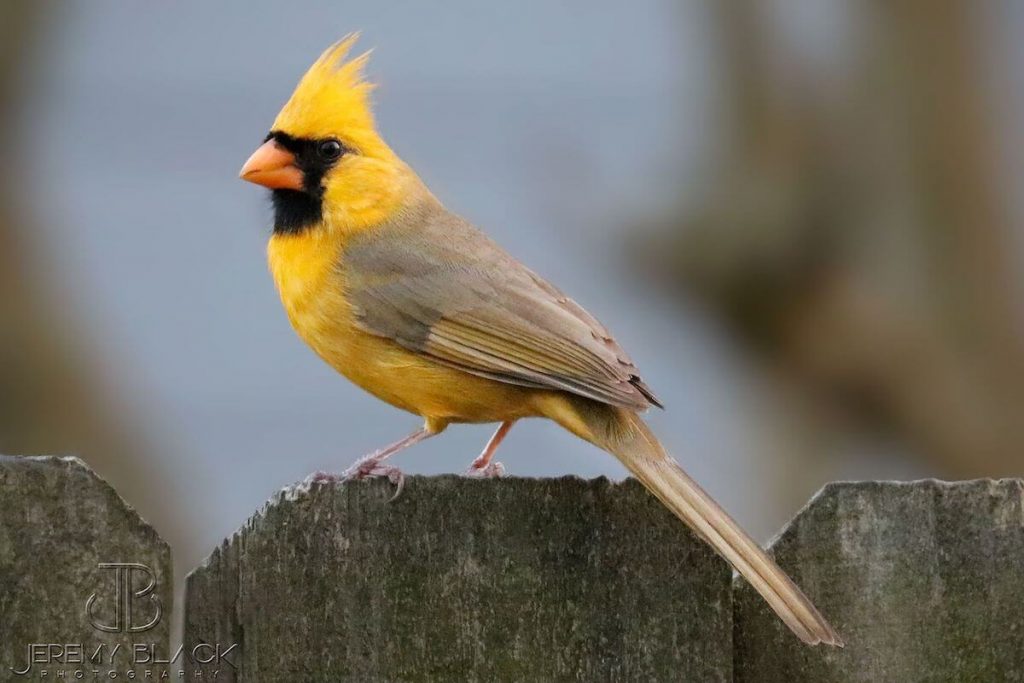
Cardinals are typically known for their iconic bright red coloring, but when one Alabama woman spotted this one-in-a-million yellow cardinal, it triggered a viral sensation.
The male northern cardinal is perhaps one of the most popular birds among bird watchers all over eastern United States. The bird is so well loved that it has been named the official bird of no fewer than seven U.S. states.
While these birds typically do not migrate, their range of habitat has slowly expanded north through the United States and even into Canada. Whether this is due to an increasing amount of winter bird feeders, or the bird’s ability to adapt to parks and suburban human habitats, the bird is quickly becoming a favorite to new areas.
Rare Yellow Cardinal ‘One in a Million’
The brilliantly hued red cardinal is quite the sight to see, but ever since Charlie Stephenson sighted a yellow cardinal at her bird feeder, she couldn’t believe her eyes.
As a seasoned birdwatcher, Stephenson had seen many a cardinal over her years. But the bird she saw in her backyard was much different – with not a red hue in sight. Instead, the bird was bearing a mustard-color coat, something Stephenson never believed possible.
So far, the best images of the bird have come fro Stephenson’s friend, professional photographer Jeremy Black, who staked out her backyard as soon as he got the call. “As soon as I saw it on her social media, I was kind of curious and I wanted to go explore and see if I could find it,” Black told Pillion at AL.com. “I finally saw it after about five hours.”
“As soon as it landed, I was starstruck,” he told Elaina Zachos at National Geographic. “It kind of took my breath away a little bit.”
Some birds turn albino or leucistic (animals that are mostly white but still produce some pigment), but this rare yellow cardinal was neither.
According to Geoffrey Hill, a bird curator at Auburn University in Alabama, the male northern cardinal is a “one in a million” with a genetic mutation that made its red feathers yellow.
In his 40 years of cardinal birdwatching, Hill has never seen a yellow bird like this in the wild.
Rare Mutation

While some birds have the ability to change the color of their feathers depending on the types of foods they eat, the yellow hues of the cardinal in question could be a sort of “genetic hack” of this system.
Cardinals and other songbirds need to consume substances called carotenoids (found in sweet potatoes and carrots) from the environment around them to produce their bright colors.
“Songbirds like cardinals almost never consume red pigments; rather they consume abundant yellow pigments,” Hill told Al.com. “So, to be red, cardinals have to biochemical convert yellow pigments too red.”
A genetic block of this color-changing pathway could be the culprit for diluting the bird’s red pigment to yellow. Hill was part of the research team that identified the enzyme — called CYP2J19 — that, for most cardinals, converts all of their yellow pigment into red feathers.
“All animals carry a DNA code, and all animals have mutations. Certain mutations have a dramatic effect on what the organism will look like. This shows that nature is not static. It is a work in progress and is changing,” Hill told WKRG.
But genetics might not be the only thing to blame for this odd-looking cardinal. According to Geoff LeBaron, Christmas bird Director at the National Audubon Society, the bird’s discoloration could also be a sign of illness.
Yellow Cardinal Sightings
Stephenson isn’t the only person to have a yellow cardinal frequenting their backyard.
Another woman in Theodore, Alabama, spotted a rare yellow cardinal in her backyard in spring of 2019. She named it “Mr. Sunshine” and posted photos of him online, only to have the post go viral with nearly 2,400 shares. She received hundreds of comments from people across the country who have been searching for years to find one.
According to Stephenson and Black, the yellow cardinal has paired up with a red female cardinal in the yard where it was originally spotted. After raising at least one chick, the couple now seems to be nesting again. (This is typical for the species.) You can follow along on their Facebook page, created by Charlie Stephenson and Jeremy Black.
While many have photographed this beautiful bird, Jeremy Black has taken some of the best. I highly suggest checking them out here.
How to Attract Cardinals To Your Yard
If you want the chance of witnessing a yellow cardinal in your backyard, you need to provide the birds with the foods they love to eat (and the proper environment).
Luckily, for bird lovers, cardinals are not particularly hard to please. With just a few simple alterations to your backyard and bird feeder set up, your yard could soon become a haven for red (and maybe even yellow) cardinals.
Cardinal Habitat
Northern cardinals are non-migratory birds, so once they discover food in your yard, they are likely to stay there year-round. This also means, however, that if cardinals are not native to your area, you won’t be able to attract them to your yard.
Cardinals can be found in the north as far as Maine and parts of southern Canada. In the south, they extend through Central America and the Gulf Coast. They are native to the west as far as South Dakota and Texas.
Tips to Attract Cardinals
As with any living being, cardinals need foot, water and shelter to survive. By meeting all of these needs, you can make your backyard a cardinal haven.
1. Provide the Right Food
Northern cardinals house a strong, thick beak, which is perfect for opening large seeds and other hearty foods. Safflower seeds, black oil sunflower seeds, and white milo are favorites among Northern Cardinals. Cardinals also enjoy eating crushed peanuts, cracked corn and berries.
2. Use Proper Feeders
You also need to make sure the feeders you use will suit the needs of your cardinal friends. The average weight of a cardinal is about 1.5 ounces, which is quite heavy for a feeder bird. Lightweight, hanging feeders should be avoided. Platform feeders and bird feeders with built-in trays that provide plenty of perching space are most preferred among these red (and sometimes yellow) feathered friends.
3. Be Careful with Food Placement
Northern cardinals preferred to be covered when feeding, so you should place food sources near trees and shrubbery in your backyard. They will enjoy the foliage and feel safer with hiding spots nearby.
4. Provide Water Sources
As with most birds, cardinals need access to fresh, clean water for bathing and drinking. Providing birdbaths or bird waterers is a great way to satisfy this need. Baths should be at least 2-3 inches at their deepest point to accommodate the size of these larger birds.
5. Offer Shelter
Cardinals enjoy secluded areas as they make them feel safe and protected. Planting trees and bushes with plenty of hiding space will make these birds feel welcome to your yard without any potential threat. Make sure to include evergreen trees and other plants to provide dense cover even in harsher winter months.
6. Encourage Nesting Sites
Cardinals will not use birdhouses or nesting boxes, unlike many other birds. By providing plenty of dense trees and bushes, you’ll increase the chances of these birds raising young in the safety of your yard. Grapevines, tall trees and shrub thickets are ideal options for cardinal nesting sites. Providing nesting materials like pine needles, small twigs, grass clippings or pet fur will also increase the chances that these birds choose your yard as their nesting site.


Carly Fraser you are a heartthrob and a good person to try to help your fellowmen to live a better life through natural history in every aspect. The time and fore going to research and know firsthand make you so much more incredible. I think you are a wonderful person. Vernon Brannon
Thanks Vernon! 🙂